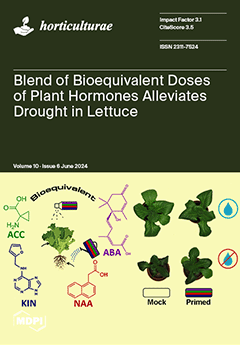The combination of high or low temperatures and high salt may cause significant harm to the yield, quality, and overall productivity of forage pea crops. The germination process, a crucial phase in the life cycle of forage peas, may be greatly influenced by varying temperature and salinity conditions. To comprehend the influence of these elements on the germination of forage peas, one must use many tactics, including the choice of resilient forage pea cultivars. The experiment aimed to evaluate the response of four forage pea cultivars (Arda, Ozkaynak, Taskent, and Tore) caused by various temperature (10 °C, 15 °C, and 20 °C) and salt (0, 5, 10, 15, and 20 dS m
−1) conditions at the germination stage using multivariate analysis and machine learning methods. An observation of statistical significance (
p < 0.01) was made regarding the variations between genotypes, temperature–salt levels, and the interaction of the observed factors: germination percentage (GP), shoot length (SL), root length (RL), fresh weight (FW), and dry weight (DW). The cultivar Tore had the best values for SL (1.63 cm), RL (5.38 cm), FW (1.10 g), and DW (0.13 g) among all the cultivars. On the other hand, the Ozkaynak cultivar had the highest value for GP (89.13%). The values of all of the parameters that were investigated decreased as the salt level rose, whereas the values increased when the temperature level increased. As a result, the Tore cultivar exhibited the highest values for shoot length, root length, fresh weight, and dry weight variables when exposed to a maximum temperature of 20 °C and a saline level of 0 dS m
−1. It was determined that temperature treatment of fodder peas can reduce salt stress if kept at optimum levels. The effects of temperature and salt treatments on the germination data of several fodder pea cultivars were analyzed and predicted. Three distinct machine learning algorithms were used to create predictions. Based on R
2 (0.899), MSE (5.344), MAPE (6.953), and MAD (4.125) measures, the MARS model predicted germination power (GP) better. The GPC model performed better in predicting shoot length (R
2 = 0.922, MSE = 0.602, MAPE = 11.850, and MAD = 0.326) and root length (R
2 = 0.900, MSE = 0.719, MAPE = 12.673, and MAD = 0.554), whereas the Xgboost model performed better in estimating fresh weight (R
2 = 0.966, MSE = 0.130, MAPE = 11.635, and MAD = 0.090) and dry weight (R
2 = 0.895, MSE = 0.021, MAPE = 12.395, and MAD = 0.013). The results of the research show that the techniques and analyses used can estimate stress tolerance, susceptibility levels, and other plant parameters, making it a cost-effective and reliable way to quickly and accurately study forage peas and related species.
Full article





